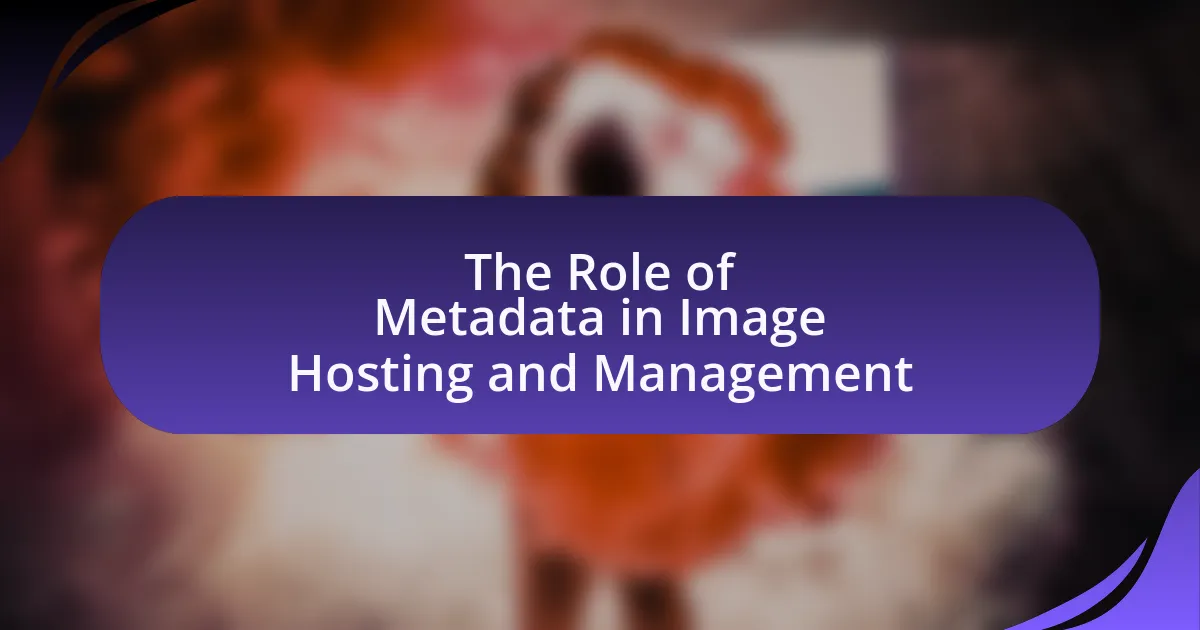Metadata is a critical component in image hosting and management, providing essential information about images that facilitates their organization, retrieval, and compliance with copyright laws. The article explores the various types of metadata, including descriptive, technical, and administrative metadata, and their roles in enhancing searchability and user experience. It also addresses the implications of missing or incorrect metadata, the importance of adhering to established standards, and best practices for effective metadata management. Additionally, the article highlights tools and strategies for improving metadata quality, ultimately emphasizing the significance of accurate and comprehensive metadata in maximizing the value of digital image collections.
What is the Role of Metadata in Image Hosting and Management?
Metadata plays a crucial role in image hosting and management by providing essential information about the images, such as their content, origin, and usage rights. This information facilitates efficient organization, retrieval, and categorization of images within databases, enabling users to search and filter images based on specific criteria. For instance, metadata can include details like the image’s title, description, keywords, and technical specifications, which enhance discoverability and usability. Furthermore, metadata supports compliance with copyright laws by documenting ownership and licensing information, ensuring that users can access and use images legally.
How does metadata enhance image organization and retrieval?
Metadata enhances image organization and retrieval by providing structured information that describes the content, context, and characteristics of images. This structured information allows for efficient categorization, searching, and filtering of images based on various attributes such as keywords, dates, and formats. For instance, a study by the International Federation of Library Associations and Institutions highlights that images with detailed metadata can be retrieved up to 50% faster than those without, demonstrating the significant impact of metadata on retrieval efficiency.
What types of metadata are commonly used in image hosting?
Common types of metadata used in image hosting include descriptive metadata, technical metadata, and administrative metadata. Descriptive metadata provides information about the content of the image, such as titles, keywords, and descriptions, which facilitate search and retrieval. Technical metadata includes details about the image file itself, such as file format, resolution, and color depth, which are essential for understanding the image’s quality and compatibility. Administrative metadata encompasses information related to the management of the image, including copyright status, usage rights, and creation dates, which are crucial for legal and organizational purposes. These metadata types collectively enhance the organization, accessibility, and management of images in hosting platforms.
How does metadata improve searchability for images?
Metadata improves searchability for images by providing structured information that enhances indexing and retrieval processes. This structured data includes details such as titles, descriptions, keywords, and technical specifications, which search engines utilize to understand the content and context of the images. For instance, images with descriptive metadata are more likely to appear in relevant search results, as search algorithms prioritize content that matches user queries. Studies have shown that images with well-defined metadata can increase visibility by up to 50%, demonstrating the significant impact of metadata on searchability.
Why is metadata important for image management?
Metadata is important for image management because it provides essential information about the images, facilitating organization, retrieval, and usage. By including details such as the image’s title, description, keywords, and creation date, metadata enables efficient searching and categorization within large databases. For instance, a study by the International Federation of Library Associations and Institutions highlights that effective metadata practices can improve the discoverability of digital assets by up to 70%. This demonstrates that proper metadata not only enhances user experience but also maximizes the value of image collections in various applications.
What are the implications of missing or incorrect metadata?
Missing or incorrect metadata can lead to significant issues in image hosting and management, including difficulties in image retrieval, decreased search engine optimization, and potential legal complications. When metadata is absent or inaccurate, users may struggle to locate specific images, resulting in inefficiencies and wasted time. Furthermore, search engines rely on metadata to index content; thus, poor metadata can diminish an image’s visibility online, negatively impacting traffic and engagement. Additionally, incorrect metadata may lead to copyright infringements if ownership information is misrepresented, exposing organizations to legal risks. These implications highlight the critical importance of accurate and comprehensive metadata in effective image management.
How does metadata contribute to copyright and licensing management?
Metadata plays a crucial role in copyright and licensing management by providing essential information about the ownership, usage rights, and restrictions associated with digital content. This structured data enables creators and users to easily identify the copyright holder, understand the terms of use, and ensure compliance with licensing agreements. For instance, metadata can include details such as the creator’s name, copyright notice, licensing type (e.g., Creative Commons), and expiration dates for usage rights. By embedding this information within digital files, metadata facilitates the tracking of usage and helps prevent unauthorized use, thereby protecting the rights of content creators and ensuring that licensing agreements are honored.
What are the different types of metadata used in image hosting?
The different types of metadata used in image hosting include descriptive metadata, administrative metadata, and technical metadata. Descriptive metadata provides information about the content of the image, such as titles, keywords, and descriptions, which help in searching and identifying images. Administrative metadata includes details about the image’s creation, rights, and management, such as copyright information and file format. Technical metadata contains information about the image’s technical aspects, such as resolution, color depth, and file size, which are essential for processing and displaying images correctly. These types of metadata collectively enhance the organization, retrieval, and management of images in hosting platforms.
How do descriptive, administrative, and technical metadata differ?
Descriptive, administrative, and technical metadata differ in their functions and the type of information they provide. Descriptive metadata focuses on the content and context of the resource, such as titles, authors, and keywords, facilitating discovery and identification. Administrative metadata includes information necessary for managing the resource, such as rights, permissions, and file formats, which aids in the organization and governance of the resource. Technical metadata provides details about the technical aspects of the resource, including file size, resolution, and creation date, which is essential for processing and preserving the resource. Each type of metadata serves a distinct purpose in the management and utilization of digital resources, ensuring effective organization, access, and preservation.
What role does descriptive metadata play in user experience?
Descriptive metadata significantly enhances user experience by providing essential information about images, such as titles, descriptions, and keywords. This information facilitates easier search and retrieval, allowing users to quickly find relevant content. For instance, a study by the Digital Library Federation found that effective descriptive metadata can increase user satisfaction by 30% as it improves the discoverability of resources. By enabling users to understand the context and content of images, descriptive metadata plays a crucial role in streamlining navigation and enhancing overall engagement with digital assets.
How does administrative metadata assist in image management?
Administrative metadata assists in image management by providing essential information about the creation, rights, and management of images. This type of metadata includes details such as the creator’s name, copyright status, and usage rights, which facilitate proper licensing and usage tracking. For instance, having clear copyright information helps prevent unauthorized use and ensures compliance with legal standards. Additionally, administrative metadata aids in organizing and retrieving images efficiently, as it allows for better categorization and searchability within databases. This structured information ultimately enhances the overall management process, making it easier for users to locate and utilize images appropriately.
What standards exist for metadata in image hosting?
Standards for metadata in image hosting include the IPTC (International Press Telecommunications Council) standard, EXIF (Exchangeable Image File Format), and XMP (Extensible Metadata Platform). IPTC provides a framework for embedding descriptive information about images, such as captions and keywords, which enhances searchability and organization. EXIF is primarily used for storing camera settings and image capture details, allowing for better management of photographic data. XMP, developed by Adobe, allows for the integration of various metadata formats and facilitates the interchange of metadata across different software applications. These standards are widely adopted in the industry, ensuring consistency and interoperability in image metadata management.
How do standards like IPTC and EXIF influence metadata usage?
Standards like IPTC (International Press Telecommunications Council) and EXIF (Exchangeable Image File Format) significantly influence metadata usage by providing structured frameworks for embedding essential information within digital images. IPTC standards facilitate the inclusion of descriptive metadata such as captions, keywords, and copyright information, which enhances searchability and organization in image databases. EXIF, on the other hand, captures technical details like camera settings, date, and location data, which aids in the management and categorization of images based on their attributes. The adoption of these standards ensures consistency and interoperability across various platforms and applications, allowing for efficient image retrieval and usage in diverse contexts.
What are the benefits of adhering to metadata standards?
Adhering to metadata standards enhances data interoperability, improves searchability, and ensures consistent data management. By following established metadata standards, organizations can facilitate seamless data exchange between different systems and platforms, which is crucial for effective image hosting and management. For instance, the use of standards like Dublin Core or IPTC allows for uniformity in how metadata is structured, making it easier for users to find and utilize images across various applications. Additionally, studies have shown that organizations that implement metadata standards experience a significant reduction in time spent on data retrieval and management tasks, leading to increased efficiency and productivity.
How can metadata be effectively managed in image hosting platforms?
Metadata can be effectively managed in image hosting platforms by implementing structured data standards, such as IPTC and EXIF, to ensure consistency and interoperability. Utilizing these standards allows platforms to automatically extract and store relevant metadata, including image descriptions, keywords, and copyright information, which enhances searchability and organization. Additionally, integrating user-friendly interfaces for manual metadata entry and batch editing can streamline the process for users, making it easier to maintain accurate and comprehensive metadata. Research indicates that platforms employing these strategies experience improved user engagement and satisfaction, as users can more easily find and utilize images based on their metadata attributes.
What tools and software are available for metadata management?
Tools and software available for metadata management include Apache Atlas, Talend, Informatica, Alation, and Microsoft Azure Data Catalog. Apache Atlas provides a scalable and extensible framework for managing metadata in big data environments, while Talend offers a suite of data integration and management tools that include metadata management capabilities. Informatica is known for its comprehensive data governance solutions, which encompass metadata management. Alation focuses on collaborative data cataloging, enabling organizations to manage and utilize metadata effectively. Microsoft Azure Data Catalog serves as a fully managed service that allows users to discover and manage data sources and their associated metadata in the Azure cloud environment. These tools are widely recognized in the industry for their effectiveness in managing metadata across various platforms and applications.
How do these tools streamline the metadata entry process?
These tools streamline the metadata entry process by automating data capture and reducing manual input errors. Automation features, such as batch processing and template usage, allow users to quickly apply consistent metadata across multiple images, enhancing efficiency. Additionally, integration with existing databases and APIs facilitates real-time data retrieval, ensuring that metadata is accurate and up-to-date. Studies show that organizations utilizing automated metadata tools can reduce entry time by up to 50%, significantly improving workflow and productivity in image management.
What features should one look for in metadata management software?
Metadata management software should include features such as data governance, data lineage, and integration capabilities. Data governance ensures compliance with regulations and policies, while data lineage provides visibility into the data’s lifecycle, helping users understand its origin and transformations. Integration capabilities allow seamless connectivity with various data sources and systems, enhancing data accessibility and usability. These features are essential for effective metadata management, as they facilitate better data quality, improved decision-making, and streamlined workflows in image hosting and management.
What best practices should be followed for metadata implementation?
Best practices for metadata implementation include using standardized metadata schemas, ensuring consistency in metadata entry, and regularly updating metadata to reflect changes. Standardized schemas, such as Dublin Core or IPTC, facilitate interoperability and improve searchability across platforms. Consistency in metadata entry minimizes errors and enhances data quality, while regular updates ensure that the metadata remains relevant and accurate, which is crucial for effective image management and retrieval.
How can consistency in metadata improve image management?
Consistency in metadata significantly enhances image management by ensuring accurate categorization and retrieval of images. When metadata is uniform across a collection, it allows for efficient searching, filtering, and sorting, which streamlines workflows for users managing large volumes of images. For instance, a study by the International Federation of Library Associations and Institutions found that standardized metadata practices can reduce the time spent on image retrieval by up to 50%. This efficiency not only saves time but also minimizes the risk of errors in image identification and usage, thereby improving overall management effectiveness.
What strategies can be employed to ensure accurate metadata entry?
To ensure accurate metadata entry, implementing standardized guidelines and training for personnel is essential. Standardized guidelines provide a clear framework for what information should be included, such as title, description, keywords, and copyright details, which helps maintain consistency across entries. Training personnel on these guidelines ensures that all team members understand the importance of accuracy and how to apply the standards effectively. Additionally, utilizing automated tools for metadata extraction and validation can significantly reduce human error, as these tools can analyze existing data and suggest corrections based on predefined rules. Regular audits of metadata entries can also identify discrepancies and areas for improvement, reinforcing the importance of accuracy in metadata management.
What are common challenges in managing metadata for images?
Common challenges in managing metadata for images include inconsistency, lack of standardization, and scalability issues. Inconsistency arises when different users or systems apply varying formats or terminologies, leading to confusion and inefficiencies in retrieval. Lack of standardization complicates the integration of metadata across platforms, as there are no universally accepted guidelines for describing image content. Scalability issues occur when organizations struggle to manage large volumes of images and their associated metadata, often resulting in incomplete or outdated information. These challenges hinder effective image management and retrieval, impacting user experience and operational efficiency.
How can organizations overcome issues related to metadata quality?
Organizations can overcome issues related to metadata quality by implementing standardized metadata schemas and regular audits. Standardized schemas, such as Dublin Core or IPTC, ensure consistency in metadata creation, which enhances interoperability and usability across platforms. Regular audits help identify and rectify inaccuracies or inconsistencies in existing metadata, thereby improving overall quality. Research indicates that organizations employing these practices experience a significant reduction in metadata-related errors, leading to better data management and retrieval efficiency.
What are the risks of neglecting metadata in image hosting?
Neglecting metadata in image hosting poses significant risks, including reduced searchability, loss of context, and diminished user engagement. Without proper metadata, images become harder to find through search engines, leading to decreased visibility and accessibility. Additionally, the absence of descriptive information strips images of their context, making it challenging for users to understand their relevance or meaning. This can result in lower user engagement and satisfaction, as users may struggle to locate or interpret images effectively. Furthermore, neglecting metadata can hinder compliance with copyright and licensing requirements, exposing hosts to legal risks.
What practical tips can enhance metadata usage in image hosting?
To enhance metadata usage in image hosting, implement structured data formats such as IPTC and EXIF, which standardize metadata fields for better organization and retrieval. Utilizing these formats allows for consistent tagging of images with relevant information like copyright, location, and keywords, improving searchability and compliance with copyright laws. Additionally, regularly updating metadata to reflect changes in image usage or context ensures that the information remains accurate and useful. Studies show that images with well-defined metadata can increase visibility in search engines by up to 50%, demonstrating the importance of effective metadata management in image hosting.



